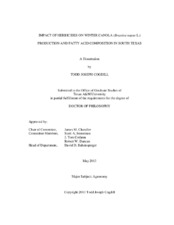| dc.description.abstract | Canola is a cool-season, oilseed crop grown throughout Europe, Canada, and the Northern Great Plains region of the United States. The expansion of canola production into new growing regions, such as the Southern Plains region, has resulted in new production challenges. The Southern Plains region cultivates canola as a winter annual compared to a spring annual for the Northern Great Plains and Canada. Given the difference in climate and weed spectrum, region-specific weed management systems need to be developed. Agronomic practices can affect seed oil content, protein content, and fatty acid composition, however the effect of herbicides on these and other characteristic of canola are unknown. Therefore, experiments were conducted in 2010 and 2011 to evaluate a broad spectrum of herbicides for potential use in South Texas canola production with respect to crop injury, effects on canola seed oil content, fatty acid composition, weed control, biomass yield, and forage quality.
Visual crop injury at 42 DAE was unacceptable for saflufenacil at both 0.12 and 0.06 kg ai ha-1 and ethalfluralin at 1.05 kg ai ha-1. Trifluralin at 1.12 and 0.56 kg ai ha-1, S-metolachlor at 2.14 and 1.07 kg ai ha-1, pyroxasulfone at 0.24 and 0.12 kg ai ha-1, and pendimethalin at 0.8 kg ai ha-1 had lowest visual injury of all treatments. Fluroxypyr applied EPOST caused severe injury at both 0.21 and 0.11 kg ae ha-1. All other EPOST treatments did not cause any visible injury. Seed oil content was not affected by the herbicides evaluated. Fatty acid composition, specifically stearic acid, oleic acid, linolenic acid, and oleic to linolenic acid ratio, was affected by herbicide treatments. This research found that protoporphyrinogen oxidase (PPG oxidase) inhibitor herbicides, such as carfentrazone-ethyl and saflufenacil, negatively affect canola oil quality. Biomass yield was improved for all herbicide treatments except pendimethalin PRE when compared to the untreated plots. Crude protein content of canola forage was not affected by herbicide treatment. Digestible dry matter appeared to be reduced by treatments that included an EPOST application of sethoxydim.
The research shows that pendimethalin and S-metolachlor may be suitable for canola production in South Texas based on low crop injury and effective weed control. Neither pendimethalin nor S-metolachlor is currently labeled for use in canola. The herbicides trifluralin, ethalfluralin, quizalofop P-ethyl, ethametsulfuron-methyl, sethoxydim, glyphosate, clethodim, and clopyralid are currently labeled for use in canola and were confirmed suitable for canola production in South Texas. Carfentrazone-ethyl is currently labeled for use in canola but the effects on oil quality should be considered. | en |


